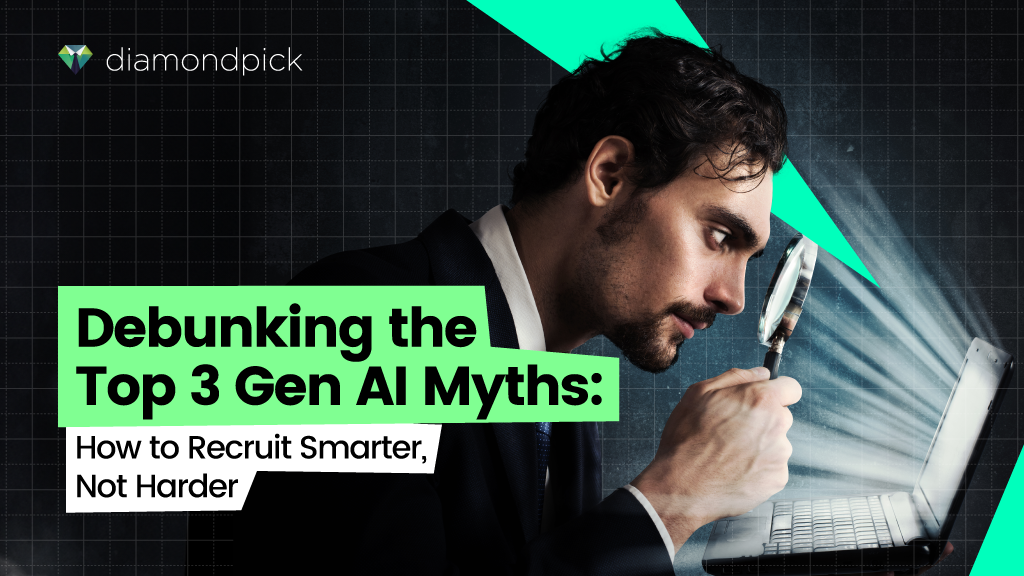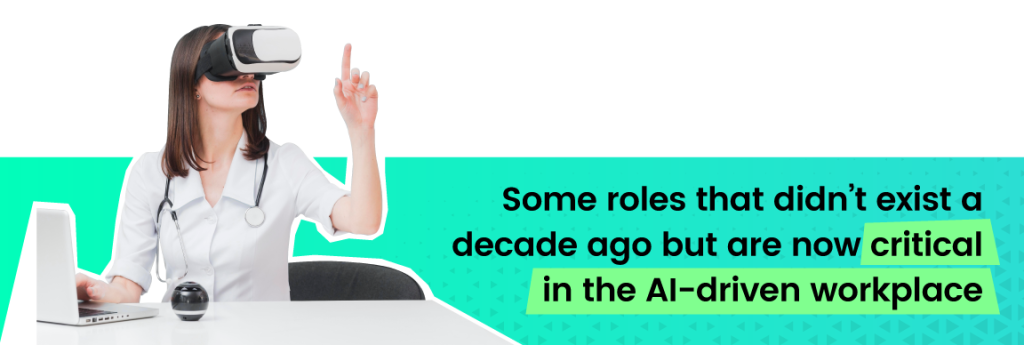
Debunking the Top 3 Gen AI Myths: How to Recruit Smarter, Not Harder
The rise of Gen AI has been nothing short of revolutionary, stirring excitement and anxiety alike. We keep hearing that “AI will automate everything”, “AI will put millions of people out of work,” and “AI can do any task imaginable” … As Gen AI becomes increasingly embedded in our daily operations, particularly in talent acquisition, numerous myths and misconceptions have emerged … Some fear that AI is taking over their jobs, while others dismiss it as merely a buzzword. But the truth lies somewhere in between; let’s delve into some of these myths and uncover the truth.
#1 The Myth: Generative AI will completely replace human recruiters.
The Reality: While generative AI is transforming many aspects of recruitment, the idea that it will completely replace human recruiters is an overstatement. AI excels in handling repetitive tasks, such as parsing resumes or scheduling interviews, but it lacks the nuanced judgment, empathy, and relational skills that human recruiters bring to the table.
Breaking it Down:
- Levels of Complexity in Hiring: Recruitment can be viewed in terms of complexity—low, medium, and high. For roles that are straightforward and have clear requirements (low complexity), Gen AI can indeed handle much of the workload autonomously. However, the more complex the role (medium to high complexity), the more nuanced the recruitment process becomes. High-complexity hiring often involves unique requirements, cultural fit, and strategic decisions that require human intuition, judgment, and empathy—things that AI cannot replicate.
-
Hiring often involves unique requirements and strategic decisions requiring human intuition, judgment, and empathy—things AI cannot replicate.
2. Gen AI as an Augmenter, Not a Replacement: Generative AI excels in augmenting human capabilities. It helps recruiters by reducing the time spent on routine tasks, allowing them to focus on strategic aspects such as building relationships with top talent, understanding client needs, and navigating complex organizational dynamics.
-
AI tools act as “assistants” that enhance productivity rather than as replacements that make human recruiters redundant.
3. The Near Future of Recruitment: In the coming months, we can expect to see a surge in Gen AI investments, which will likely lead to increased demand for skilled human recruiters to implement and use these tools effectively.
-
The surge in Gen AI investments will drive demand for human recruiters skilled in leveraging these emerging tools.
AI can enhance the recruitment process by automating routine tasks and providing valuable data-driven insights. However, human recruiters will remain indispensable for tasks that involve personal interaction, nuanced decision-making, and ethical considerations. So, rather than fearing displacement, recruiters should prepare to work alongside AI to enhance their capabilities and effectiveness.

#2 The Myth: Generative AI will lead to massive job losses in the recruitment industry and beyond.
The Reality: Rapid Gen AI adoption will drive higher demand for skilled professionals who can leverage and manage these AI tools effectively. The surge in investments and advancements in generative AI is expected to create numerous new job roles, especially in developing, deploying, and optimizing these technologies. As companies grapple with tech debt and growing demands, the need for human expertise in utilizing AI effectively will only grow.
Breaking it Down:
1. Increased Demand for Human Expertise: The surge in investments in Gen AI is expected to create new job roles. Businesses will need skilled professionals to develop, deploy, and manage new technologies. Gen AI will also increase the demand for recruitment professionals as companies look to build teams capable of implementing and managing these technologies effectively.
-
The more companies invest in AI, the more jobs will be created.
2. Creating New Opportunities: As Gen AI technologies enable employees to achieve higher productivity levels (ability to do 5x the amount of work), the need for specialized roles and new job functions will only increase.
-
Rather than eliminating jobs, AI will drive the need for more personnel to handle the expanded scope of work and new AI-driven projects.
3.New Opportunities: The rise of AI also brings new job roles, such as AI ethicists, who ensure that AI systems operate fairly, and AI trainers, who fine-tune models for specific tasks.
-
Some roles that didn’t exist a decade ago but are now critical in the AI-driven workplace.

#3 The Myth: Gen AI is Biased and Discriminatory
The Reality: Bias in AI is a real concern, but it stems from the data and algorithms rather than the technology itself. AI systems reflect the biases present in the data they are trained on. If historical data reflects discriminatory practices, the AI can unintentionally perpetuate those biases.
Breaking it Down:
1. Bias Reflects Human Input, Not AI Intent: Gen AI systems learn from data created by humans, which means they can reflect the biases present in that data. This is not a flaw of the AI itself but a reflection of the biases inherent in the data it was trained on. Biases can manifest in various ways, such as favoring certain demographics or inadvertently filtering out diverse candidate
-
Ongoing efforts should be made to audit and refine AI models to ensure they are trained on diverse datasets.
2.Bias as a Risk, Not an Inevitability: While bias is a significant risk, it is not an unavoidable outcome. By treating bias as a critical issue and incorporating safeguards, AI developers and users can work towards minimizing discriminatory outcomes and ensuring more inclusive technology.
-
Implementing robust testing and continuous monitoring can help identify and mitigate bias.
Bias in Gen AI AI can be managed and reduced through proactive measures. For example, developers can implement bias-detection algorithms, diversify training datasets, and continuously monitor and adjust the AI’s outputs to ensure more equitable and fair results.

Generative AI is reshaping talent acquisition in profound ways, but it is not without its challenges and limitations. While it enhances efficiency and offers new capabilities, the myths surrounding AI often exaggerate its potential and impact. The key to leveraging AI effectively lies in understanding its strengths and limitations and ensuring it complements human skills rather than replacing them.
As we navigate the evolving landscape of AI in recruitment, it’s essential to stay informed, critically evaluate the technology, and remain vigilant about ethical considerations. By doing so, we can harness the power of AI to create a more efficient, fair, and innovative talent acquisition process.
For some expert insights into these myths and more, tune into our Hireside Chats podcast episode – Is There Anything Gen AI Can’t Do (Yet)? – and get your Gen AI facts straight!
